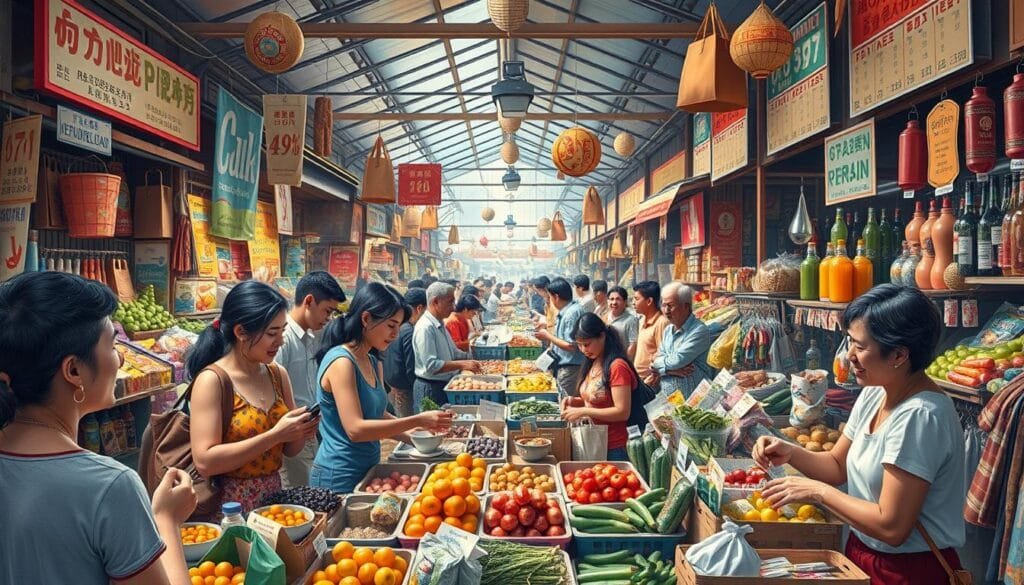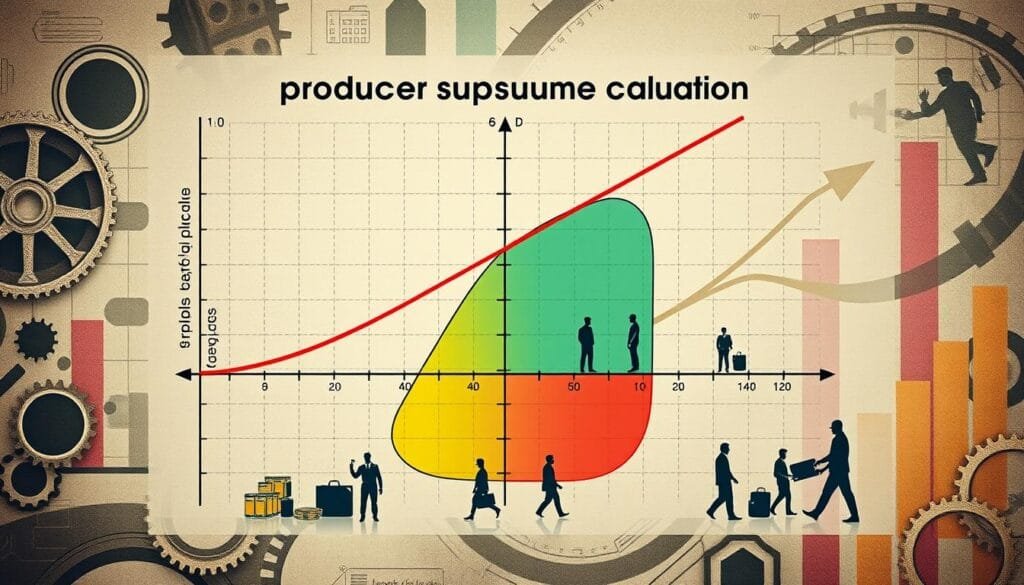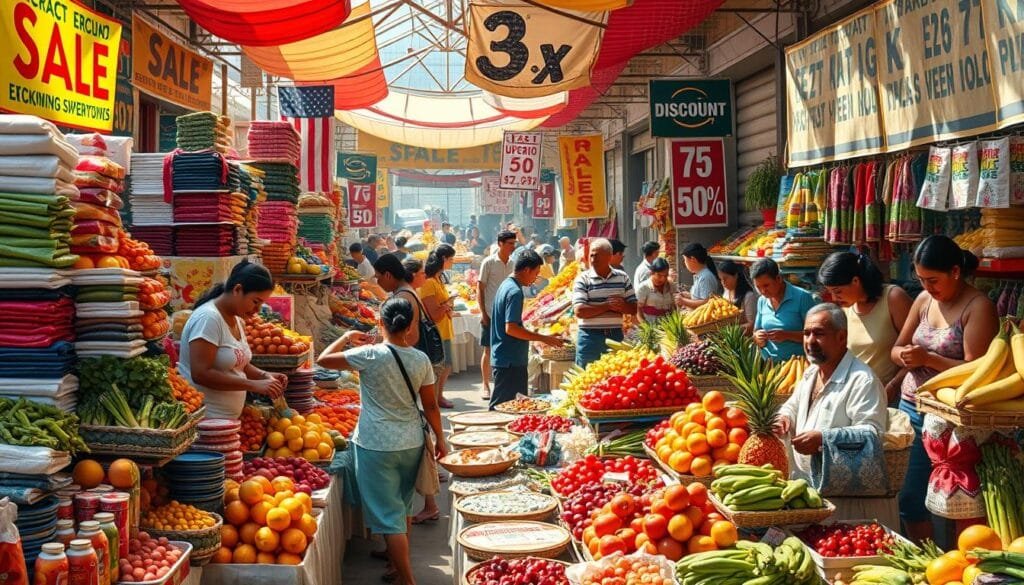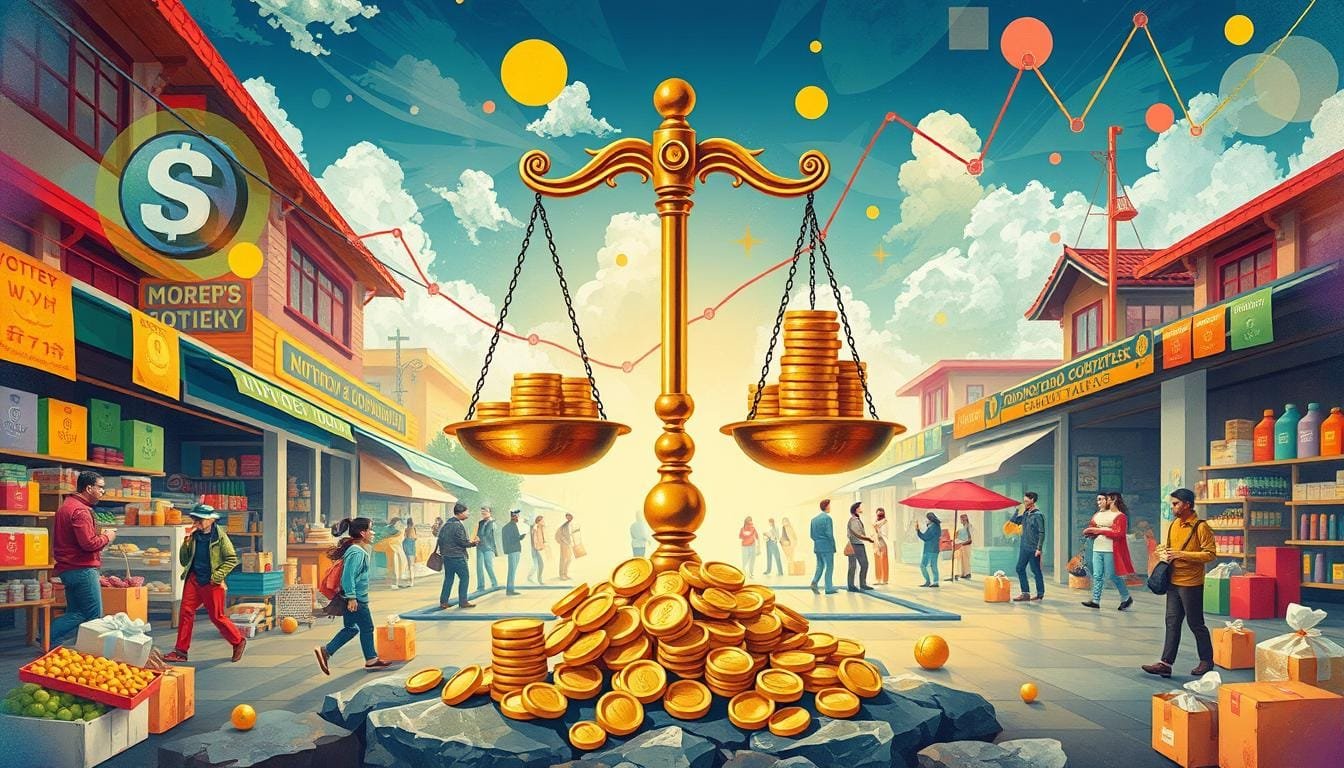Ever wondered why we sometimes have too many goods that no one buys? Surplus in economics dives into the reasons behind this. It looks at market forces, how people behave, and government decisions. This article will make sense of economic surplus for you. It explains different types of surpluses, from government budget extras to stock overflows. Understanding surplus helps grasp how economies work and impacts our lives.
Key Takeaways
- A surplus occurs when the amount of an asset or resource exceeds the portion needed and used.
- Consumer surplus results from a situation where supply exceeds demand, leading to prices lower than the maximum price consumers would pay.
- Producer surplus measures the benefit to producers selling at market prices above their minimum selling prices.
- The sum of consumer and producer surplus is referred to as social surplus or total surplus.
- Market disequilibrium arises from a surplus, indicating inefficiency in product flow through the market.
What is Economic Surplus?
Economic surplus is key to understanding how markets work. It shows the difference between what consumers and producers gain and their costs. This idea helps us see if markets are doing well.
Definition of Surplus
Surplus is about economic gains. It is the gap between what people are willing to pay and what they do pay. It’s also the gap between the price producers accept and what they get. This includes both consumer surplus and producer surplus. These reflect market efficiency and welfare.
Types of Surplus
There are two main types of surplus: consumer and producer surplus. Knowing these types of economic surplus helps understand economic principles:
- Consumer Surplus: This is when products cost less than the highest price consumers would pay. For example, if something is priced at $50 but buyers would pay up to $70, the consumer surplus is $400. This shows their savings.
- Producer Surplus: This is when items are sold for more than the lowest price sellers would take. For example, if the price is $50 but sellers would accept $20, the producer surplus is $600. This shows their extra profit.
The total economic surplus is the sum of consumer and producer surplus. It peaks when supply and demand balance. Markets that work well make sure resources go where they’re needed most. This benefits everyone involved.
Consumer Surplus Explained
Consumer surplus is a key economics idea. It shows how buyers benefit when prices are lower than what they’re willing to pay. By looking at the demand curve, we can figure out consumer surplus. This shows its impact in real situations.
Definition and Calculation
Consumer surplus is the gap between the most a buyer would pay and the actual price. This gap is a benefit to buyers. To find consumer surplus, we study the demand curve’s area above the current price.
Take the tablet market as an example. People would pay $90 for 20 million units, but the actual price is $80. This creates a surplus in the shape of a triangle above the $80 price and under the demand curve. We use a formula (CS = ½ * base * height) to calculate it:
- Base: Units sold at equilibrium (28 million)
- Height: The gap between what buyers would pay ($90) and the price ($80), which is $10
So, the consumer surplus is ½ * 28 million * $10. This shows the big economic advantage for buyers here.

Real-life Examples
Real examples help us see consumer surplus’s effect. Look at holiday sales when items are cheaper. For instance, if a toy normally costs $50 but sells for $30 during a sale, buyers save $20 per toy.
Also, price ceilings on essential drugs show consumer surplus changes. If a new drug has a price limit of $400, not $600, there’s a clear benefit shift. The surplus changes, showing how policies can help buyers.
To learn more about consumer surplus, including how to calculate it, check out Investopedia.
Producer Surplus Explained
Understanding producer surplus is key for looking at business profits and economic gains in a market. It’s the gap between what producers will take and what they end up getting.

Definition and Calculation
The formula for calculating producer surplus is:
Total Revenue – Marginal Cost = Producer Surplus
It shows the extra earnings producers get by selling goods above their production costs. When market prices go up, so does producer surplus. It drops when prices fall.
Real-life Examples
Let’s see how this works with 20 widget-making companies. Their production costs vary from $2.50 to $3.50 per widget. With a market price at $3.00, the one making widgets for $2.50 enjoys a $0.50 surplus for each one. This surplus shows how profits can soar as prices go beyond production costs.
In the world of farming, producers often see big surpluses. This happens when market demand boosts their selling price way over their costs. These cases highlight how vital producer surplus is for understanding producers’ economic benefits.
| Company | Production Cost per Widget | Market Price per Widget | Producer Surplus per Widget |
|---|---|---|---|
| Lowest-cost Producer | $2.50 | $3.00 | $0.50 |
| Average-cost Producer | $3.00 | $3.00 | $0.00 |
| Highest-cost Producer | $3.50 | $3.00 | -$0.50 |
What is Surplus in Economics?
In economics, a surplus happens when there’s more of a product than people want, at current prices. This can lead to too much stock or too much saved money. It’s important to know about surplus because it helps us understand its effect on market efficiency.

Consumer surplus is the gap between what someone would pay and what they spend. For example, if you’re willing to spend $175 on shoes but find them for $100, you’ve saved $75. This saving, or surplus, is shown as a triangle on graphs between the price and demand curve. Imagine saving $22.50 on a purchase, calculated by a formula using the sale price of $9 and wanting to spend 5 more.
Producer surplus is where makers get more than they’d accept at the least. Like, earning $5 more per hour over the least they’d take. This too is shown as a triangle, where a surplus of $20 is found with some basic math.
Total economic surplus combines both consumer and producer gains, showing how efficient a market is. Things like new tech, government help, and more demand can change how much surplus there is. It also affects the lowest price producers are willing to accept. Rising costs of goods also has an impact.
Surplus can be used in different ways, like putting money back into the business, sharing profits with shareholders, or getting rid of extra stock by selling it off or giving it away. If you want to learn more about how supply, demand, pricing, tech, and policies affect surplus, check out understanding surplus in economics.
| Surplus Type | Definition | Example Calculation |
|---|---|---|
| Consumer Surplus | Difference between willingness to pay and actual price | $25 (willing to pay $75, actual price $50) |
| Producer Surplus | Difference between lowest acceptable price and received price | $5 per hour (minimum $10, received $15) |
| Total Economic Surplus | Combined total of consumer and producer surplus | Sum of consumer and producer surpluses |
Understanding surplus in economics lets us see how it makes competitive markets work better. Good use of surplus can improve market efficiency and stability.
Market Disequilibrium and Surplus
Market disequilibrium is key in macroeconomics. It occurs when the market has too much or too little of a product. This often leads to price changes as the market seeks balance.
Impact on Supply and Demand
When supply and demand don’t match, it shows in market disequilibrium. For example, let’s say there are 680 million gallons of gasoline available at $1.80 each. But people only want 500 million gallons. This leaves a surplus of 180 million gallons. Surplus effects on prices then push prices down as sellers try to sell their extra gas. On the flip side, when there’s not enough of something, prices usually go up.
Price Floors and Ceilings
Sometimes governments step in to fix prices with laws. They set price floors or ceilings to help balance the market. But, these actions have consequences of their own. For instance, a cap on rent can make landlords less likely to rent out their properties, leading to fewer available homes. Similarly, a minimum wage that’s too high can lead to too many people looking for work and not enough jobs.
| Price per Gallon | Quantity Demanded (millions) | Quantity Supplied (millions) |
|---|---|---|
| $1.00 | 720 | 500 |
| $1.20 | 700 | 550 |
| $1.40 | 600 | 600 |
| $1.80 | 500 | 680 |
| $2.20 | 350 | 700 |
Understanding how market disequilibrium works is essential. It helps policymakers and market players see how surplus or government actions affect prices. This knowledge helps keep the economy stable and growing.
Total Economic Surplus
Total economic surplus is the total benefit both consumers and producers get from a market. It’s key for assessing economic health and market efficiency.
Consumer Surplus + Producer Surplus
The sum of consumer surplus and producer surplus makes up the total economic surplus. Consider a fan who expects to pay $1,000 for a concert ticket but finds it for $200. This gives them an $800 surplus. On the other hand, an ice cream vendor selling at $5.50, above their $3.50 bottom line, gains a $2 surplus per pint.
Imagine a market equilibrium where 5,000 items sell at $8 each.
- Here, consumer surplus is 1/2 x 5,000 x ($8 – $5) = $12,500.
- Producer surplus is 1/2 x 5,000 x ($5 – $3) = $7,500.
This brings the total surplus to $20,000. It proves how precise economic health measurement mirrors market benefits.
Graphing Total Surplus
When we graph surplus, we picture supply and demand curves. Consumer surplus is the area over the price and below the demand curve. Producer surplus sits under the price but above the supply line.
Graphs show economic balance and benefit distribution. In a perfect market, surplus peaks at equilibrium. Price limits, however, cause loss and lower the total surplus.
Graphing total economic surplus not just helps academically but guides policymakers. It aims at market efficiency and economic good.
Conclusion
Understanding economic surplus helps us judge how well markets work. It’s key for shaping policies. We look at consumer, producer, or total surpluses to see where resources go. This tells us if the market is stable.
Different surpluses give us clues for smart business moves and accurate predictions. Good resource use makes the market stable and efficient. It helps everyone.
Consumer surplus shows the value buyers get, figured out by a simple formula. When prices change, it affects how much people buy. For basic needs like milk and water, the surplus can be huge because people always need them.
Karl Marx gave us a way to think about labor and profit’s role in markets. His ideas, and those from other economic thinkers, make us think harder about how markets work. These theories help us understand the complex world of economics.
FAQ
What is the definition of economic surplus?
Economic surplus is the extra quantity that’s not needed by the market at present prices. It shows up as budget surpluses when government income is more than its spending. Or as inventory surpluses with products that aren’t sold yet.
What are the main types of economic surplus?
There are two main types: consumer and producer surplus. Consumer surplus happens when items are sold for less than what people are ready to pay. Producer surplus is when items are sold for more than their production costs.
How do we calculate consumer surplus?
To find consumer surplus, we take the highest price consumers would pay and subtract the market price. We do this for all items bought. This shows the benefit consumers get.
Can you provide a real-life example of consumer surplus?
An easy example is when stores have holiday sales with big discounts. People who would pay more end up saving money. They get more value than what they pay.
How is producer surplus defined and calculated?
Producer surplus is what sellers get above the least they’d accept. It’s found by taking the market price and subtracting the cost to make each item. This equals their profit.
Can you provide real-life examples of producer surplus?
A good example is farmers making extra money when crop prices go up unexpectedly. They sell their produce for more than it cost to grow, making a higher profit.
What is the broader economic impact of surplus?
Surplus changes how much things cost and what’s available in the market. It can lead to changes in how the economy is planned and managed. It shows when supply and demand aren’t balanced.
How does market disequilibrium due to surplus affect prices?
A market surplus usually means prices drop to sell extra items. This helps stabilize the market but can mean lower prices for shoppers.
What role do price floors and ceilings play in managing surplus?
The government sets price limits to help control big surpluses or shortages. By doing this, they aim to keep the market steady.
How do consumer surplus and producer surplus relate to total economic surplus?
The total economic surplus is when you add consumer surplus to producer surplus. It shows the overall market health and efficiency.
How is total economic surplus usually represented graphically?
On a graph, it’s shown as the space between supply and demand curves and prices. This helps us see market balance and who gains from economic activities.
